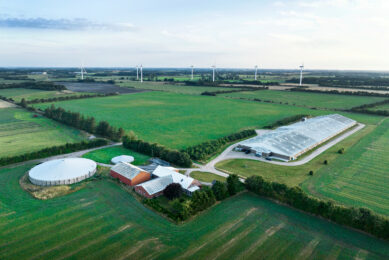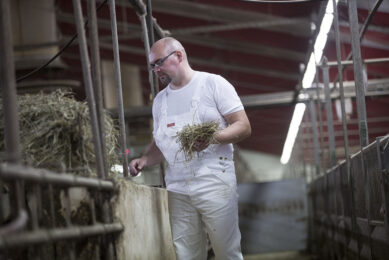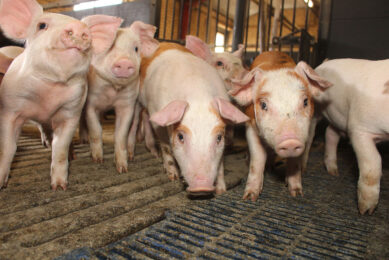Aarhus University: Life is too short for many pigs
Piglet mortality in Denmark has been increasing in line with increasing litter size. Scientists from the Faculty of Agricultural Sciences have reviewed existing knowledge about the problem and suggest methods to reducing it.
Danish pig farmers excel at producing many pigs per sow per year but there is also a downside to their success. Many of the pigs that are born die before they are a few hours or a few days old. Identifying the causes of this high mortality and investigating the potential means of reducing it are the subjects of a new report from the Faculty of Agricultural Sciences at Aarhus University.
In Denmark the number of pigs born per litter has been increasing steadily for the past 15 years and has now reached an average of 16.1 pigs per litter. Unfortunately, the number of dead pigs – whether stillborn or dead within the first few days after birth – has also increased. The proportion of dead pigs has been approximately 24 percent of total born piglets in commercial herds during the past six years.
Based on the recent public debate on piglet mortality in Denmark, the Danish Veterinary and Food Administration requested scientists from the Faculty of Agricultural Sciences to prepare a report outlining the problem.
Many – but small and weak – pigs
The scientists point out that the increase in piglet mortality has several causes.
The emphasis on breeding towards larger litter sizes during the period 1992-2004 seems to be a major part of the problem of the high percentage of stillborn pigs and pigs that die within the first few days after birth. The total number of born piglets is phenotypically strongly related to the number of pigs born undersized, weak or underdeveloped. These piglets have an increased risk of dying either during or shortly after birth.
The scientists point out that the increase in piglet mortality has several causes.
The emphasis on breeding towards larger litter sizes during the period 1992-2004 seems to be a major part of the problem of the high percentage of stillborn pigs and pigs that die within the first few days after birth. The total number of born piglets is phenotypically strongly related to the number of pigs born undersized, weak or underdeveloped. These piglets have an increased risk of dying either during or shortly after birth.
The Danish breeding index is defined by Danish Pig Production. In 2004 the trait “Live pigs at day 5” replaced the trait ‘Total number of born pigs” in the selection index. Based on Danish data, it was expected to result in a decrease in mortality rate. However, the expected decrease in piglet mortality rate has so far not shown up in data from production herds. Litter size has increased while mortality has stagnated.
The direct causes of mortality are several. Some pigs suffer from a lack of oxygen during birth. They may end up as stillborn pigs. In other cases they survive birth but are weak due to the lack of oxygen. Small and weak piglets cool easily because they are typically less vigorous and their chances of survival are not good. They are, for example, less apt to move out of the way when the sow lies down.
This brings us to another important cause of the high piglet mortality: being crushed by the sow. Pigs with a low birth weight and a low body temperature are particularly susceptible to being crushed the first days after birth.
Starvation and cooling are also a problem because small and cold piglets are more susceptible to disease.
Reduced welfare
Hunger, cold, lack of oxygen, disease and being crushed by a large sow – these are the fates of approximately four piglets in every litter born in Denmark. Apart from reducing production due to losing so many pigs, it is also a welfare problem for the liveborn piglets that die after birth.
– A large proportion of the pigs that die within the first few days after birth have in all likelihood suffered from pain, hunger, fear or stress for anywhere from a few minutes up to half a day. The high proportion of dead piglets therefore poses an ethical and welfare problem, the scientists state in their report.
Hunger, cold, lack of oxygen, disease and being crushed by a large sow – these are the fates of approximately four piglets in every litter born in Denmark. Apart from reducing production due to losing so many pigs, it is also a welfare problem for the liveborn piglets that die after birth.
– A large proportion of the pigs that die within the first few days after birth have in all likelihood suffered from pain, hunger, fear or stress for anywhere from a few minutes up to half a day. The high proportion of dead piglets therefore poses an ethical and welfare problem, the scientists state in their report.
A side effect of large litter sizes is that there are not enough nipples on the sow to provide for all her piglets. In order to solve this problem pig farmers use nursing sows. A nursing sow raises her own litter for three to four weeks after which her pigs are weaned and the sow is given a new litter to raise. This poses welfare problems for the sow because she is penned for a longer period than if she only has to raise her own litter.
Improvements in several areas
Fortunately, reducing the present high piglet mortality is not impossible. The report outlines several possibilities.
Fortunately, reducing the present high piglet mortality is not impossible. The report outlines several possibilities.
Including piglet mortality directly in the breeding index is an obvious choice for reducing mortality. However, the report points out that it would not lead to an immediate fall in piglet mortality on commercial farms, as it takes three to four years for breeding results to work their way through the breeding system and into the animals on commercial farms.
An effect can also be achieved through improved management and better pen conditions.
Increased monitoring of farrowing can potentially reduce the number of stillborn pigs and neonatal deaths, as can improvements in the pigs’ local environment. The latter practice requires the development of methods that are practical to use. Means such as straw and extra heat sources placed in the right locations in the pen could comprise some of the possibilities.
An intensification of expert advice regarding sow health may also improve conditions for the piglets.
Increased monitoring of farrowing can potentially reduce the number of stillborn pigs and neonatal deaths, as can improvements in the pigs’ local environment. The latter practice requires the development of methods that are practical to use. Means such as straw and extra heat sources placed in the right locations in the pen could comprise some of the possibilities.
An intensification of expert advice regarding sow health may also improve conditions for the piglets.
(Text: Janne Hansen)











